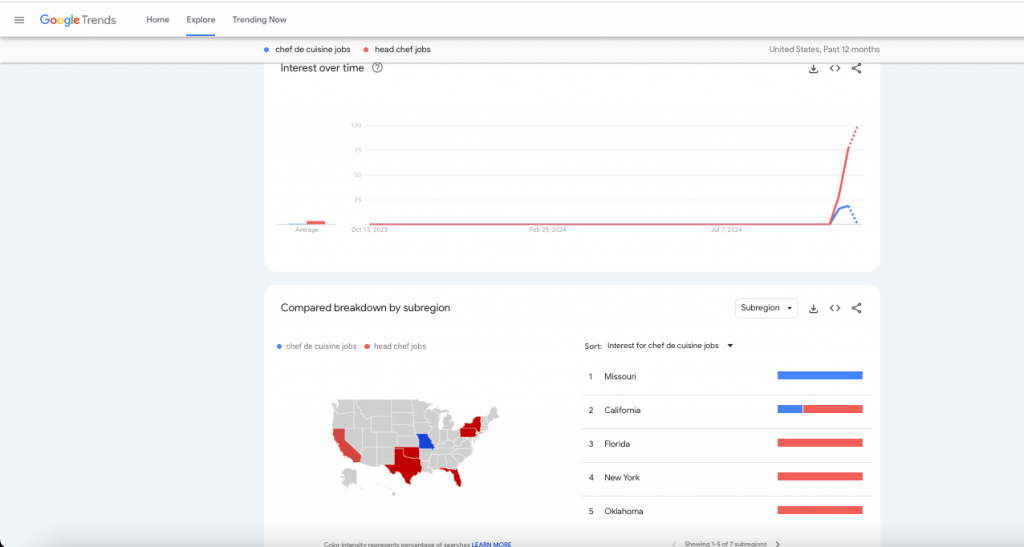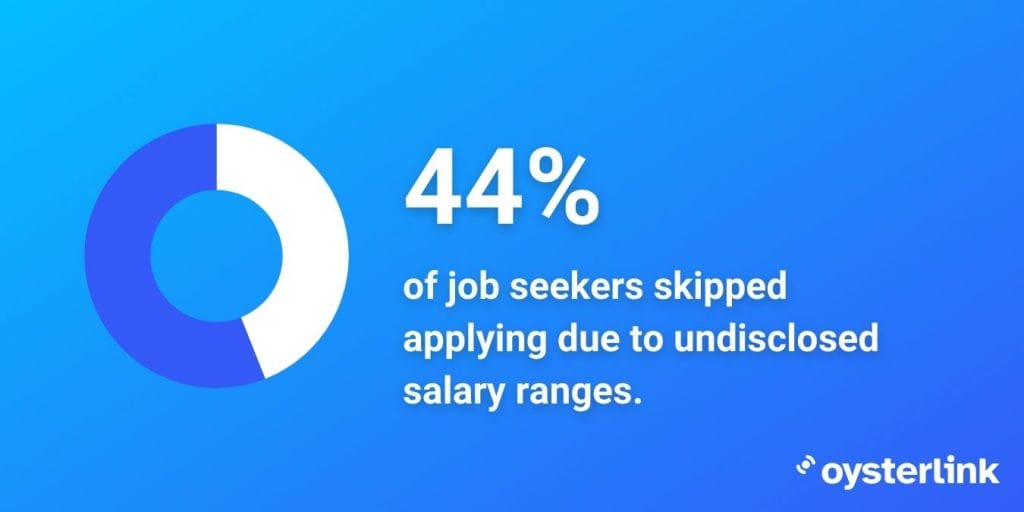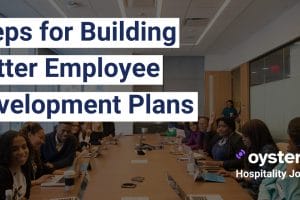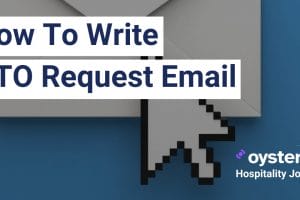In this article, we’ll share tips on creating effective online job postings to help Hiring Managers attract qualified candidates and stand out in a competitive job market.
1. Understand Your Applicants
To appeal to your target candidates, you need to understand their challenges and find ways to address them.
Below are some of the most common problems hospitality and restaurant workers face, along with potential solutions.
| Challenge | Solution |
|---|---|
| High cost of living | Offer competitive salaries |
| Long working hours | Provide flexible shifts |
| High stress | Offer benefits that promote overall well-being |
| Physical demands | Invest in ergonomic equipment and tools |
| Difficult customers | Train employees to handle challenging interactions |
When determining salaries for employees, the first step is to make sure they align with market rates. OysterLink’s salary page provides average annual salaries for various hospitality and restaurant positions.
You can explore wages by state, major cities and other factors that affect pay. This resource ensures your salaries are competitive and helps your employees manage the cost of living crisis.
Offering flexible scheduling and a comprehensive benefits program helps manage workers’ long hours, unpredictable schedules and high stress. While this requires effort and resources, it can make your job posting more attractive, showing you value employees’ needs.
Finally, adopting operational practices like providing ergonomic equipment and ongoing professional training ensures employees are adequately supported to meet the demands of their roles.
2. Write a Clear Job Title
When writing job titles, make sure they accurately reflect the role. For example, don’t use “Team Leader” when you mean “Kitchen Manager.”
While “Team Leader” typically refers to managing a team to ensure operational efficiency and quality standards, the “Kitchen Manager” title clearly indicates responsibility for overseeing kitchen flow, managing staff and ensuring food safety.
Including career levels, such as “Entry-Level Pastry Chef,” can also clarify that applicants with limited experience, like a year as a Pastry Cook, are encouraged to apply and that training will be provided.
Whatever job title you choose, ensure it includes keywords commonly understood and used within the industry to maximize visibility and relevance.
3. Create a Compelling Job Description
When writing hospitality and restaurant job descriptions, highlight what makes your company and the position unique.
For example, in the job overview section, you might say:
At our restaurant, we take pride in creating memorable experiences for every guest. We foster a warm, inclusive and respectful environment, offering career growth opportunities for those willing to put in the effort.
This approach attracts career-driven candidates who want to advance within the organization and feel supported in their goals. It also gives applicants insight into your culture, showing that you value respect, open communication and hard work.
For free samples of compelling job descriptions, OysterLink offers a variety tailored to different roles within restaurants and hospitality establishments. You can copy the text directly or download them as PDFs.
4. Use Relevant Keywords
Using the same keywords that job seekers search for can help you attract more applicants.
For example, if you’re hiring for a Head Chef position and debating whether to use “Head Chef” or “Chef de Cuisine,” Google Trends can guide your decision by showing search patterns over time. Google Trends is free and easy to use. Simply enter the search terms, time range and location to generate data.
In the example below, we compared searches for “Head Chef jobs” and “Chef de Cuisine jobs” in the U.S. over the past 12 months. As you can see, “Head Chef jobs” (in red) shows higher interest over time compared to “Chef de Cuisine jobs” (in blue).

This suggests that using “Head Chef” in your job title may attract more applicants.
However, if you’re targeting a specific state, say Missouri, the breakdown by subregion section shows that the term “Chef de Cuisine jobs” receives higher interest there. It’s recommended to customize your job description depending on where you’re located.
Another way to identify relevant keywords is by reviewing competitors’ job descriptions and noting frequently used terms. Just be careful not to overstuff your job description with keywords, so it still sounds natural.
5. Be Transparent About Pay and Benefits
Being transparent about your compensation package offers several benefits.
Job seekers use information about pay to decide whether to apply for a job. According to a survey, 44% of job seekers didn’t apply for a position because the salary range wasn’t disclosed.

Aside from attracting more applicants, transparency also sets clear expectations from the start, reducing the back-and-forth of salary negotiations. While some negotiation is normal, being upfront about pay can expedite the whole recruitment process.
Since benefits are an essential part of your overall compensation package, it’s equally important to lay them out early. Sharing your company’s compensation package makes your job ad more appealing to potential candidates.
Take a look at these four different types of benefits to determine if your offer stands out.
| Health and wellness | Financial and retirement | Paid time off | Work-life balance |
|---|---|---|---|
| Health insurance | 401(k) matching | Vacation days | Flexible scheduling |
| Employee assistance program | Employee stock ownership plan | Sick days | Employee recognition awards |
| Gym memberships | Access to financial advisors | Holiday pay | Cross-training ipportunities |
6. Specify Skills and Qualifications
List the minimum required skills and qualifications to perform the job well. This ensures applicants understand what’s necessary for the role without feeling overwhelmed.
Include both hard and soft skills in your list. Hard skills refer to abilities that can be learned through training and experience, while soft skills are personal traits that affect how an individual interacts with colleagues.
For example, hard skills for a Hotel Manager include budgeting, managing finances and controlling costs. Meanwhile, in-demand soft skills for this role include leadership, interpersonal abilities and organizational skills.
Qualifications refer to the experience and credentials that prove a candidate’s ability to perform the job effectively. These may include formal education (high school diploma, bachelor’s degree or associate degree), certification (Food Handler card, Food Manager certification) and relevant work experience (number of years spent in a restaurant or hospitality establishment).
7. Optimize for Mobile Devices
In the past four years, there has been a noticeable shift from desktop to mobile usage. Starting in July 2024, the number of mobile users has steadily surpassed desktop users.

To cater to both mobile and desktop users, ensure your job descriptions are optimized for both platforms. This will help engage candidates and make it easy for them to apply, no matter which device they use.
8. Include a Call to Action
A call to action (CTA) prompts candidates to take the next step. CTAs in your job description can be as simple as an “Apply Now” button or more detailed, such as this CTA at the end of the overview of our Baker job description:
If you have at least one year of experience working as a Baker and are knowledgeable in using basic baking tools, such as electric mixers, food processors and kitchen scales, we encourage you to apply.
You can choose to use both a button and a text CTA to maximize engagement. The button offers convenience, allowing candidates to apply immediately, while the text CTA encourages applicants who meet your criteria to take action.
9. Post on the Right Platforms
Choosing the right platform is just as important as creating good job descriptions. Even if your job description is written perfectly, it won’t attract qualified candidates if it’s not posted where your target audience is active.
Platforms can be divided into two major groups: social media and job search engines.
Social media platforms
Some of the best social media platforms for job postings are Facebook, Instagram and TikTok.
- Facebook: Offers a “Post a Job” feature on business pages for free. Job seekers can apply from both desktop and mobile, and Hiring Managers can connect with candidates, schedule interviews and chat directly through Messenger.
- Instagram: Provides a creative way to advertise job openings by focusing on visual content. You can use reels, stories or static posts to make your job postings exciting.
- TikTok: Many recruitment agencies recommend TikTok for hiring because of its features like the “For You Page” (FYP), which boosts content visibility and helps posts go viral.
Job search engines
While general job boards like LinkedIn, ZipRecruiter and Monster.com can provide visibility, service industry-specific platforms like Culinary Agents, Hcareers and Poached Jobs can help you reach a more relevant audience.
However, many of these niche platforms come at a significant cost. Fortunately, OysterLink, also a hospitality-focused job search engine, allows you to post as many job openings as needed without any fees.
The platform simplifies the job posting process by providing free job descriptions, so all you need to do is enter the job title, contact details and company information. Once submitted, you can post your hospitality job online and start connecting with candidates immediately.
Below is a comparison of the pricing for all the hospitality-focused platforms mentioned.
| Platform | Price |
|---|---|
| Culinary Agents | $150/month plan |
| Hcareers | $249/post |
| Poached Jobs | $59/post |
| OysterLink | FREE |
10. Follow Up and Engage With Applicants
Multiple sources say that the best candidates are often off the market within 10 to 13 days. As a Hiring Manager, it’s important to engage effectively with candidates to demonstrate interest and avoid losing them during the recruitment process.
Here are some ways to follow up and engage with applicants:
- Make the application process easy: Many job seekers dislike uploading both a resume and cover letter, only to be asked to manually input the same information. Streamline the process to enhance their experience.
- Respond within 24-48 hours: Prompt replies leave a positive impression and help applicants feel valued by ensuring timely communication.
- Provide a recruitment timeline: In addition to replying promptly, share an overview of the process, so candidates know what to expect.
- Inform candidates if they’re not selected: Avoid ghosting applicants. The hospitality industry is closely connected and maintaining a positive reputation is important. Even if they aren’t chosen for the current role, you can consider them for future openings.
Conclusion
Writing standout hospitality job postings is simpler than you think. By understanding your candidates’ needs, being clear about the role, and showcasing your company’s unique perks, you can easily attract more applicants. Use these tips to create job ads that get results — 3x more applications, faster hires and a stronger team.
FAQs About Online Job Posting Tips
Focus on your company culture and growth opportunities. Highlight what sets you apart, such as work-life balance, benefits and any unique perks. Use clear, engaging language that speaks directly to the needs of your target candidates.
Include a clear, precise job title, a compelling company overview, essential job responsibilities and qualifications. Don’t forget to mention pay and benefits upfront to attract more candidates.
Use industry-standard terms that candidates are likely to search for. Be specific and clear about the role’s responsibilities and career level. Avoid using vague or overly creative titles that might confuse applicants.
Avoid jargon and being too vague in your descriptions. Ensure your posting includes the necessary skills and qualifications without overwhelming the reader. And remember, always be transparent about pay.
Use analytics tools provided by job boards or platforms. Track how many views, clicks, and applications you get to gauge what’s working. Adjust keywords, job titles and descriptions based on performance metrics.

Written by Rea Gierran
With a background in Communication Arts, Rea’s expertise lies in content marketing and copywriting. Her published works can be seen on online news websites such as Rappler and Adobo magazine. Outside of her work, Rea takes on the role of a “momager” for Shiro, a TikTok dogfluencer.

Reviewed by Stefan Petrov
With over 10 years of experience as a writer and editor, Stefan has worked in the automotive, IT, health and hospitality industries. Familiar with Google Search Console and other SEO tools like Ahrefs and Semrush, Stefan uses his experience to create content that’s visually appealing to the user but also ranks in the SERPs.




